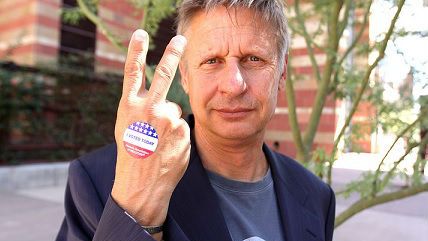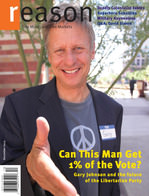4 Other Reasons to Be Bullish on Gary Johnson's Polling
Beyond drawing nearly 10%, the Libertarian is disproportionally attracting independents and Millennials, despite low name recognition


The headline interest in the Libertarian Party's prospects this November were tidily summed up by FiveThirtyEight three weeks ago: "Pay Attention To Libertarian Gary Johnson; He's Pulling 10 Percent vs. Trump And Clinton." That number has settled to about 9 percent nationwide since, but the basic set-up remains the same: Johnson is polling around four times higher than he was at this time in 2012, in a Black Swan political year featuring historically loathed and remarkably statist major-party candidates. It's an unprecedented opportunity for limited-government politics and argument.
And those aren't the only reasons for Libertarian (and libertarian) optimism lurking within these recent polls. Here are four more:
1) Pollsters are actually including Gary Johnson. Five of the seven national presidential election polls (as gathered by the ever-useful RealClearPolitics) since the Libertarian National Convention last month have also included Johnson. (He has averaged 10 percent in those.) The surveys that excluded Johnson, in case you want to send a candygram, were Rasmussen Reports and Economist/YouGov.
From the moment he sewed up the L.P. nomination, Johnson pivoted to one major message: include me in the polls. That's not as straightforward as you might expect—before the major-party conventions in 2012, for example, Johnson was also included in a total of five national polls, but only across five months, not two weeks. (He averaged slightly less than five percent in those.)
Ten percent is within shouting distance of 15 percent, which is the ticket to nationally televised presidential debates. It's also a nice round number that generates attention and headlines, in theory helping to inch those results still higher. If Johnson is being included in three-quarters of the national surveys and averaging double-digits in those, it's going to be awfully hard for polling companies to exclude him.
2) Johnson is competitive among the largest and fastest-growing political bloc: independents. The Libertarian candidate's single most shocking poll result thus far was a June 5-8 Fox News survey that found him edging out Hillary Clinton among independents, 23 percent to 22 percent (Donald Trump topped both, with 32 percent).
Johnson beating Clinton among independents is an outlier, but his overall competitiveness among that bloc is not. The former New Mexico governor averages twice as much support among non-Democrats/Republicans as he does overall.
Here's a quick snapshot in reverse chronological order of how the three leading presidential candidates are doing among independents. In the parentheses are the polls' universe of independents compared to Democrats and Republicans:
HC 24% DT 24% GJ 12%, Reuters/Ipsos June 11-15 (Dem/Rep/Ind 44%/34%/13%)
HC 30% DT 29% GJ 17%, CBS News June 9-13 (D/R/I 35%/29%/36%)
DT 30% HC 23% GJ 16%, Guardian/SurveyUSA June 8 (D/R/I 33%/26%/38%)
DT 32% GJ 23% HC 22%, Fox News June 5-8 (D/R/I 41%/35%/20%)
DT 33% HC 27% GJ 19%, IBD/TIPP May 31-June 5 (D/R/I 35%/31%/33%)
DT 36% HC 29% GJ 10%, Quinnipiac May 24-30, (D/R/I 35%/29%/26%)
For going on three decades, Gallup has been asking voters whether they consider themselves to be Democrats, Republicans, or independents. The latter category has held the top slot every month since December 2012, and every year since 2008. Independents were 33 percent of the electorate in 1988; 45 percent last month.
Independents are not automatically libertarians, but libertarians are more likely to appear among their ranks, and are far more likely to be independent themselves. More importantly, even those majority of independents who otherwise adhere predictably to one of the two main political groupings are still more open to ideas and politicians outside their tribe. Their disloyalty, combined with the shrinking popularity of party affiliation and America's ongoing calamity of misgovernance, make our political moment continuously dynamic and unpredictable.
When Gary Johnson and the L.P. do disproportionately well among a growing and dynamic political bloc, that softens the ground for more libertarian argumentation across the political spectrum. Particularly among the most unaffiliated demographic of them all, Millennials.
3) The Libertarian message is doing best among Snake People Millennials. In every presidential poll with an age breakdown conducted since the Libertarian National Convention, Gary Johnson has performed better among 18-to-34-year-olds than any other age group, usually by a lot.
Here is a list of how the three candidates are faring among Millennials, followed in parentheses by Johnson's overall support, and his second-most popular demographic:
HC 41% DT 27% GJ 10%, Guardian/SurveyUSA (6% overall, 6% for ages 50-64)
HC 38% DT 29% GJ 18%, Fox News (12% overall, 12% 35-54)
HC 29% DT 28% GJ 24% (ages 18-24), IBD/TIPP (11% overall, 16% 25-54)
HC 40% DT 28% GJ 8%, Quinnipiac (5% overall, 8% 35-49)
Many dreams have crashed on the rocky shores of Millennial political affection, but Gary Johnson certainly believes there's some there there, and he's joined in this analysis by pollster John Zogby, at the end of last month argued that "the Libertarians could have a breakthrough year," due to their potentially "very special appeal to Millennials." From Zogby's analysis:
They will decide the outcome in 2016. Donald Trump's support is miniscule among this group and Clinton does not generate any enthusiasm among younger voters because she appears to many to be a combination of too establishment and too disingenuous….To be sure, many will hold their nose and vote for Clinton because of their fear of a Trump victory. But the real question is will there be enough excitement to get Millennials out to vote. While early reports on the Libertarian ticket of former New Mexico governor Gary Johnson and former Massachusetts governor Bill Weld suggest that they may draw votes away from Trump, I think they may actually hurt Clinton even more. […]
Johnson and Weld just may have the most compelling message for Millennials. They are running as fiscal conservative purists and can draw from a group that is deeply concerned about both college debt and unparalleled public debt. And they are social libertarians: pro-choice, anti-government meddling in matters of personal privacy, decriminalization of most drugs, and they oppose United States meddling in foreign adventures and war. These young people are America's First Global generation and they are diverse and less inclined to see other peoples and cultures as the "other."
While this radiates more optimism than even I am willing to muster, it is worth noting that early polling does show Johnson to be pulling evenly from Clinton and Trump. Now just imagine if anyone actually knew who he was!
4) Nobody knows who Gary Johnson is, but they're willing to learn. The recent Bloomberg poll asked people to answer three questions about the candidates who were not their first choice: Could you ever support them, would you never support them, or are you not sure?
Only 6 percent of non-Hillary voters said that they could ever support her, and only 7 percent of non-Trumpites said they could conceive of Team Orange. Johnson? A full 22 percent of respondents imagined that they could vote for him, and a further 25 percent said they were not sure (compared to just 2 percent and 1 percent for Clinton and Trump, respectively). The Quinnipiac poll found that 83 percent didn't know enough about Johnson to have a favorable or unfavorable opinion of the man.
So will that change? CNN is hosting a townhall meet-the-Libertarians broadcast next week for Johnson and William Weld. Soon, millions of Americans will be in position to get to know the Libertarian ticket. It will be fascinating to see what they think.


Show Comments (109)